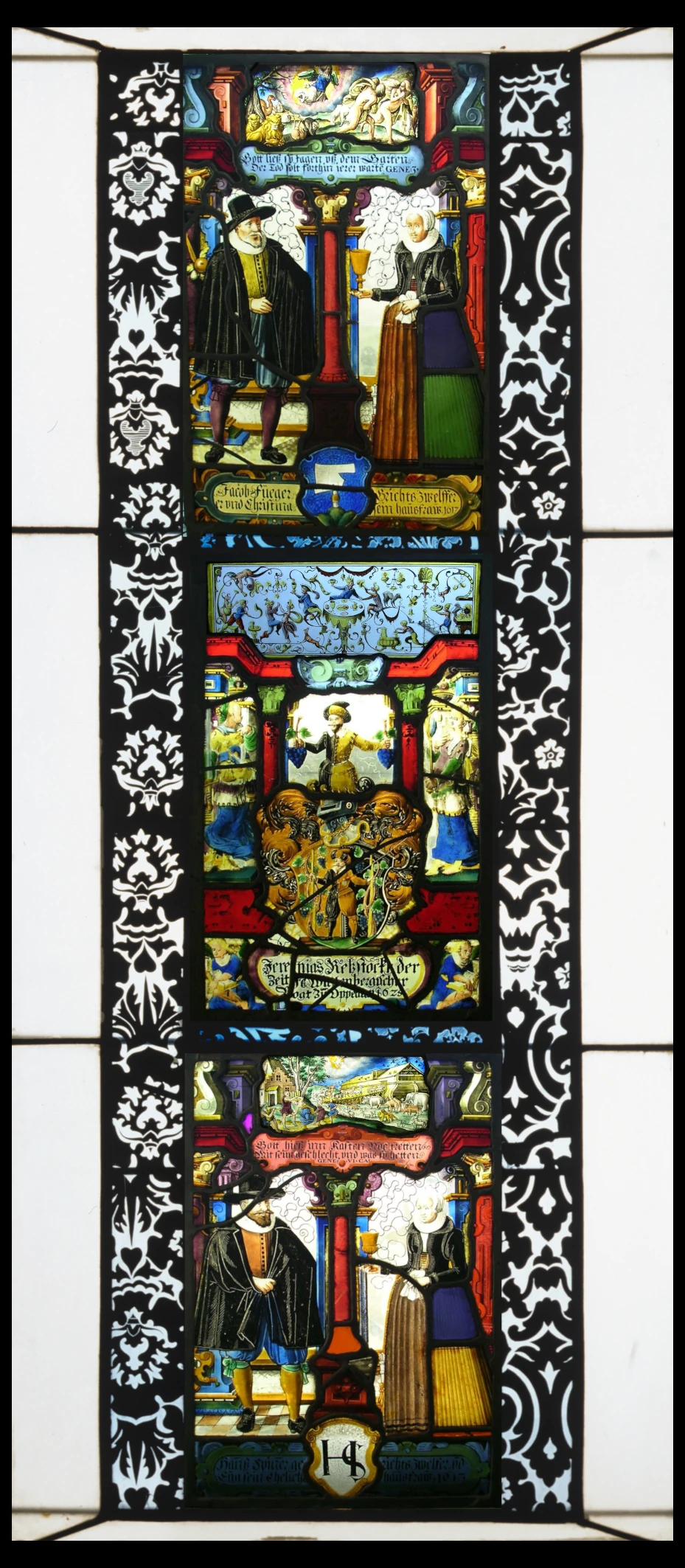262 Staufenberg Castle Window 2
Motif above: Jacob Fueger, court judge of Oppenau, with wife, coat of arms: butcher’s axe on Dreiberg (Allerheiligen monastery), Fueger died in 1631 as a “sorcerer” because he had met with the devil on the small plain. Headpiece: Expulsion from paradise; Inscription above: “Gott ließ sy jagen uß dem Garten – Der Tod solt forthin ierer warte. GENE: 3″; Inscription at the bottom:“Jacob Füeger Gerichtszwelffer he and Christina his housewife 1617″
Motif centre: Jeremias Rebstock, Württemberg bailiff of Oppenau, with his wife in 1625. Header: Scenes from the life of J. Rebstock, seated at a richly laid table, musicians and a dancing couple on the left. Inscription: “Jeremias Rebstock the Time … Wür.enbergian Bailiff of Oppenau 1625″
Motif below: Hans Spinner, blacksmith and court twelfth (+August 1636) with his wife in Oppenau, headpiece: Noah’s Ark with many exotic animals; Inscription at the top:“God called inn Kasten Noe tretten With his sex and what they had GENE 3 VI. CA:”; Inscription below:“Hannß Spinner ge – richtszwelfer. du Eva sein Eheliche – hausfraw. 1617.“
Motif above: Jakob Füeger was a butcher, which is why his house sign shows the butcher’s axe on the Dreiberg. The Dreiberg comes from the coat of arms of Allerheiligen Abbey. Füeger was probably a feudal tenant of Allerheiligen Abbey and carried out the slaughtering in the valley. In the church register of Oppenau it is noted: Jacob Fieger, the butcher of the parish, donated 25 shillings on the feast of St James, 4 shillings for a mass, 21 shillings for St John and another 2 shillings. His crime: Devil met in man form, wedding on “Small level” Christ Hauers (pig) beaten.
In 1617, his daughter Katharina Kempf became landlady at the Ratsstuben, she fled to Freudenstadt, where she was landlady at the “Güldener Barben” as Katharina Stein, which burnt down in 1632 and with it the whole of Freudenstadt. She had to flee again when it became known that her father had been executed as a witch. Her trail is then lost in the “turmoil of the 30-year war” and the headpiece of the disc depicts the expulsion of Adam and Eve from paradise.
Motif centre: Jeremias Rebstock came from a well-known Strasbourg patrician family. His term of office as Württemberg bailiff in the Oppenau valley under Duke Johann Friedrich lasted from 1613 to 1629. Before that he was the Württemberg forester in Calw. During his term of office, the great town fire of 1616 and the rebuilding of Oppenau lasted until 1617. He died in Oppenau in 1636.
One of his main tasks as a forestry expert was probably the procurement of wood for the production of charcoal for the Württemberg “ironworks” in Renchtal. The name Rebstock also appears as the bailiff of Fürsteneck Castle near Oberkirch-Bottenau.
Families with the name Rebstock still exist today in France and also in Swabia. For families who have symbolically expressed their relationship to the juice of the vine by including the grape, the vine man, the vine knife or the vine in their coat of arms, the coat of arms of the Rebstock family is even characterised by four vines.
Jeremias Rebstock, who was born on 4 June 1579 in Jesingen as the son of Schultheiss Martin Rebstock and, after his parents died of the plague, was brought up by relatives.
The coat of arms was granted by the Electoral Saxon Council and Chancellor, also Comes Palatinus Gerg Godelmann. We also know that when Jeremias returned to his homeland, he was first a noble bailiff in Ehestetten in the service of the nobles of Spät, then forester in Zellerbad (Bad Liebenzell), before finally becoming bailiff in Oppenau.
The probably very wealthy Oppenau bailiff can also be found in two documents in the Karlsruhe General State Archives under the fonds no. 34/196 and 34/397. In it, Susanna Beinhaimin, widow of Johann Scheublin (other spelling = Schaiblin) of Durbach, undertakes before the court of Staufenberg (deed dated 24 April 1629) to repay a capital of 200 guilders borrowed from Rebstock. In addition to the capital, 10 guilders interest was payable. The peculiar dwelling of Mr and Mrs Scheublin in Durbach served as a pledge. In a list of 10 items from 1631, the bailiff Rebstock, who lived in Strasbourg at the time, put his total claim on the heirs of the deceased Johann Schaiblin at 242 guilders and 3 shillings. Rebstock came to Durbach twice to collect his debt. For this he claimed one guilder and 6 shillings “for consumption”. To enforce his claim he had also been “uff Staufenberg beim Amptmann gewesen” for which he charged 5 shillings.
After Schaiblin’s death, he travelled to his widow in Oberkirch twice. He charged 1 guilder and 6 shillings for the food.
„Den 12. August Ao. 1631 bin ich von Straßburg biß in den Durbach dißer Schuldt halb geritten, weil Herr Amptmann nicht zu Hauß geweßen ein Tag warten müßen, verzert 2 Gulden“
Rebstock was finally satisfied in full by the lienholder (Allerheiligen Abbey), the provost of Oberkirch, on 15 September 1631, which he acknowledged with his signature.
Motif below: Hannß Spinner was probably not only a craftsman, but also a wealthy “citizen”. The church register of Oppenau records: Hannß Spinner, the blacksmith in the small town, dies in August 1636.





